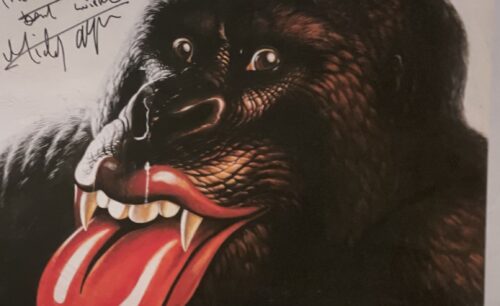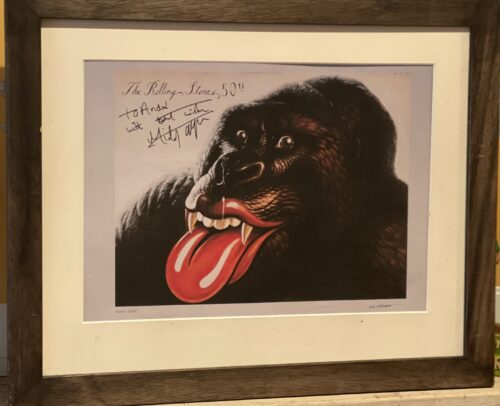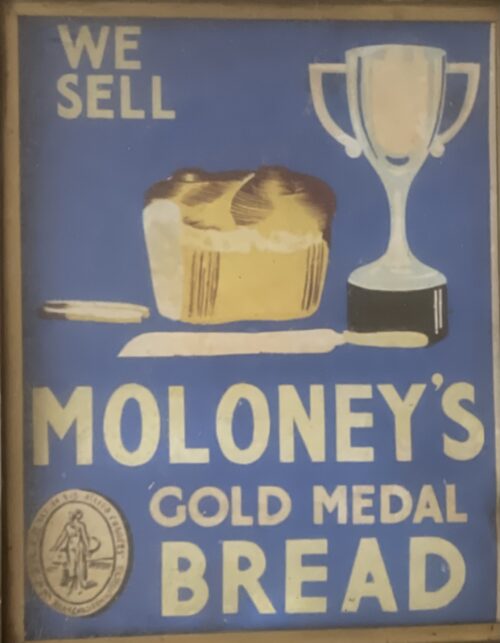-

 45cm x 38cm The Sunday Press was a weekly newspaper published in Ireland from 1949 until 1995. It was launched by Éamon de Valera's Irish Press group following the defeat of his Fianna Fáil party in the 1948 Irish general election. Like its sister newspaper, the daily The Irish Press, politically the paper loyally supported Fianna Fáil. The future Taoiseach Seán Lemass was the managing editor of the Irish Press who spearheaded the launch of the Sunday paper, with the first editor Colonel Matt Feehan. Many of the Irish Press journalists contributed to the paper. 'When I open the pages, I duck' was Brendan Behan's description of reading The Sunday Press, for the habit of published memoirs of veterans (usually those aligned to Fianna Fáil) of the Irish War of Independence. It soon built up a large readership, and overtook its main competitor the Sunday Independent, which tended to support Fine Gael. At its peak The Sunday Press sold up to 475,000 copies every week, and had a readership of over one million, around one third of the Irish population. Like the Evening Press, the paper's readership held up better over the years than that of the flagship title in the group, The Irish Press, and it might have survived as a stand-alone title had it been sold. However, with the collapse of the Irish Press Newspapers group in May 1995, all three titles ceased publication immediately. The launch of Ireland on Sunday in 1997 was initially interpreted by many observers as an attempt to appeal to the former readership of The Sunday Press, seen as generally rural, fairly conservative Catholic, and with a traditional Irish nationalist political outlook. When Christmas Day fell on Sunday in 1949, 1955, 1960, 1966, 1977, 1983, 1988 and 1994 the paper came out on the Saturday. Vincent Jennings at the age of 31 became editor of The Sunday Press in 1968, serving until December 1986, when he became manager of the Irish Press Group. Journalists who worked at the press include Stephen Collins served as political editor his father Willie Collins was deputy editor and Michael Carwood became sports editor of The Sunday Press in 1988 until its closure in 1995.
45cm x 38cm The Sunday Press was a weekly newspaper published in Ireland from 1949 until 1995. It was launched by Éamon de Valera's Irish Press group following the defeat of his Fianna Fáil party in the 1948 Irish general election. Like its sister newspaper, the daily The Irish Press, politically the paper loyally supported Fianna Fáil. The future Taoiseach Seán Lemass was the managing editor of the Irish Press who spearheaded the launch of the Sunday paper, with the first editor Colonel Matt Feehan. Many of the Irish Press journalists contributed to the paper. 'When I open the pages, I duck' was Brendan Behan's description of reading The Sunday Press, for the habit of published memoirs of veterans (usually those aligned to Fianna Fáil) of the Irish War of Independence. It soon built up a large readership, and overtook its main competitor the Sunday Independent, which tended to support Fine Gael. At its peak The Sunday Press sold up to 475,000 copies every week, and had a readership of over one million, around one third of the Irish population. Like the Evening Press, the paper's readership held up better over the years than that of the flagship title in the group, The Irish Press, and it might have survived as a stand-alone title had it been sold. However, with the collapse of the Irish Press Newspapers group in May 1995, all three titles ceased publication immediately. The launch of Ireland on Sunday in 1997 was initially interpreted by many observers as an attempt to appeal to the former readership of The Sunday Press, seen as generally rural, fairly conservative Catholic, and with a traditional Irish nationalist political outlook. When Christmas Day fell on Sunday in 1949, 1955, 1960, 1966, 1977, 1983, 1988 and 1994 the paper came out on the Saturday. Vincent Jennings at the age of 31 became editor of The Sunday Press in 1968, serving until December 1986, when he became manager of the Irish Press Group. Journalists who worked at the press include Stephen Collins served as political editor his father Willie Collins was deputy editor and Michael Carwood became sports editor of The Sunday Press in 1988 until its closure in 1995. -

 62cm x 42cm John Patrick Healy (9 March 1931 – 5 December 2014), known as Jackie Healy-Rae, was an Irish Independent politician who served as a Teachta Dála (TD) for the Kerry South constituency from 1997 to 2011.
62cm x 42cm John Patrick Healy (9 March 1931 – 5 December 2014), known as Jackie Healy-Rae, was an Irish Independent politician who served as a Teachta Dála (TD) for the Kerry South constituency from 1997 to 2011.Early and private life
Healy-Rae was the first of six children born to Daniel and Mary Healy, and grew up on his family's farm at the foot of Mangerton Mountain, near Kilgarvan in County Kerry. The Rae part of his surname came from the name of the Healys' farm, Reacashlagh. He was educated at the local National School in Kilgarvan. He emigrated to the United States in 1953 but soon returned to Ireland. He played for the local hurling and Gaelic football teams in Kilgarvan, where he won two senior county hurling titles with the club in 1956 and 1958. Healy-Rae was also a saxophone player with the Kilgarvan Dance Band. By the 1960s, he was well established in the plant hire business in south Kerry. In 1969, he became a publican when he purchased an old premises that had been closed for some time in Kilgarvan. The family pub is now run by his son, Danny. Healy-Rae was married to Julie Healy, but the couple separated in 1977.Two sons, Danny and Michael were members of Kerry County Council for the Killarney and Killorglin local electoral areas respectively before becoming TDs. His eldest daughter Joan (Mrs. Larkin) teaches in a Catholic Schoolin New York. His other daughter, Rosemary, is a barrister-at-law. She was appointed to a paid position on the Criminal Injuries Compensation Tribunal in 2007. She was re-appointed, for three further years, by Justice Minister Dermot Ahern on 11 November 2010.A son, Denis, runs his own business, and another son, John Healy (he does not use Rae), is a full-time official with and former President of the Garda Representative Association.Political career
Early involvement
Healy-Rae first became involved in politics in the 1960s. He headed several Fianna Fáil by-election campaigns, most notably the election of John O'Leary to the Dáil in 1966. O'Leary retained the seat for thirty-one years. Healy-Rae later lent his services to several other Fianna Fáil election campaigns in County Limerick, County Cork and County Galway. In 1973, Healy-Rae was first co-opted to Kerry County Council as a Fianna Fáil member, following the death of sitting Kerry County Councillor Michael Doherty. He was elected to the council in his own right in 1974 and re-elected in every subsequent election. Healy-Rae served on the council for 30 years, until he had to resign his seat because of the abolition of the dual mandate in 2003. During the 1970s and 1980s, Healy-Rae served three times as Fianna Fáil's director of elections in Kerry South. In this capacity he was given the task of delivering two of the three seats for the Fianna Fáil Party.Election to Dáil Éireann Healy-Rae broke from Fianna Fáil in controversial circumstances prior to the 1997 general election. When the party refused to nominate him as a candidate in Kerry South, he decided to run as an Independent candidate. This move surprised the party, with many commentators giving him little chance of getting elected. However, Healy-Rae took a seat and denied Fianna Fáil the chance of taking a second seat in the constituency.
After the election, the Fianna Fáil and Progressive Democrats prospective government was still short of an overall majority. Healy-Rae was one of four Independent TDs (the others were Harry Blaney, Tom Gildea and Mildred Fox) who supported the government throughout its five-year term and rejected the opposition Fine Gael. In return for this support he secured funding for projects in his constituency and chairmanship of the Environment committee. His policy approach could be defined as populist, primarily driven by his rural background and constituency, and he frequently demanded upgrades to public services such as schools and roads in his constituency as the price of his support for the government. Healy-Rae contested the 2002 general election and although his seat looked in doubt at some stages of the campaign and he received only the fourth-highest number of first-preference votes, he was narrowly re-elected, winning the third seat. He sat through fewer than half the meetings of an Oireachtas committee tasked with dealing with social welfare he received €20,000 a year to chair. He got up and left during 25pc of the meetings of the committee leaving the vice-chairman, Charlie O'Connor, to oversee the meetings and absented himself entirely from a further 25pc of meetings, despite a convention that chairmen appointed by the government should fully chair all meetings.External support for Fianna Fáil
He was again re-elected to the Dáil at the 2007 general election and signed a confidence and supply deal with Fianna Fáil. Promising to support the government in return for investment in the Kerry South constituency. The details of this deal were not made public. Healy-Rae has been criticised for not making the details of the deal public and for supporting the government over highly controversial cutbacks (in contrast to Finian McGrath who made the details public by entering his deal into the Dáil record and who withdrew his support from the government in 2008, over cutbacks in the health sector). He was confronted publicly by members of the Kerry Public Sector Workers Alliance about his continual support for cutbacks and for the Irish bank bailout. Healy-Rae said he was powerless as he had only one vote and that they "should talk to the Green Party that are making the big changes".Retirement
On 26 June 2008, Healy-Rae announced that he intended to retire at the next general election. His son Michael Healy-Rae was selected as a candidate by the Healy-Rae organisation on 28 October 2010,and was elected at the 2011 general election.Death
Healy-Rae died on 5 December 2014, at Kerry General Hospital in Tralee after a long illness. -

 Art and craft classes were held at the Maze,Long Kesh Prison & prisons in the South as part of educational programmes, some by the prison authorities and some by the prisoners themselves. Prisoners could gain qualifications and formal courses in art history were also offered. In addition, arts and crafts were pursued at an informal level within the prison. Murals were painted on the walls of both the H-Blocks and the Nissen huts within the cages/ compounds. Handicrafts made in the prison could be sold on the ‘outside’, with proceeds going to prisoners’ families. In 1996 the Prison Arts Foundation (PAF) was founded, with the aim of providing access to the arts for all prisoners, ex-prisoners, young offenders and ex-young offenders in Northern Ireland. During the latter years of the Maze and Long Kesh Prison, the PAF promoted access to the arts by organising professional artist residencies and workshops in the H-Blocks. Security considerations placed constraints on materials permitted and the type of art and crafts that could be produced in the prison. For example, glass and ‘inflammable’ paint were not allowed. However, the availability of tools and materials varied across the site and over the years. And prisoners also improvised with materials to hand.
Art and craft classes were held at the Maze,Long Kesh Prison & prisons in the South as part of educational programmes, some by the prison authorities and some by the prisoners themselves. Prisoners could gain qualifications and formal courses in art history were also offered. In addition, arts and crafts were pursued at an informal level within the prison. Murals were painted on the walls of both the H-Blocks and the Nissen huts within the cages/ compounds. Handicrafts made in the prison could be sold on the ‘outside’, with proceeds going to prisoners’ families. In 1996 the Prison Arts Foundation (PAF) was founded, with the aim of providing access to the arts for all prisoners, ex-prisoners, young offenders and ex-young offenders in Northern Ireland. During the latter years of the Maze and Long Kesh Prison, the PAF promoted access to the arts by organising professional artist residencies and workshops in the H-Blocks. Security considerations placed constraints on materials permitted and the type of art and crafts that could be produced in the prison. For example, glass and ‘inflammable’ paint were not allowed. However, the availability of tools and materials varied across the site and over the years. And prisoners also improvised with materials to hand. -

 26cm (empty)
26cm (empty)Bunratty Mead is a traditional wine, produced from an ancient Irish recipe of pure honey, fruit of the vine and natural herbs. It's a medium sweet wine, with a wide taste appeal, and suitable for all important occasions. As the drink of the ancient Celts, Mead derives much of its appeal through Irish Folklore, which is legendary of this mystical drink with strong attachments to Ireland.
In the days of old when knights were bold, the drink of choice was mead. Much more than an extraordinary legendary drink with strong attachments to Ireland, mead can be traced back as many centuries before Christ. It became the chief drink of the Irish and was often referred to in Gaelic poetry. Mead's influence was so great that the halls of Tara, where the High Kings of Ireland ruled, were called the house of the Mead Circle. Its fame spread quickly and soon a medieval banquet was not complete without it.


Even the church recognised the value of this fabulous drink. Legend has it that St. Finian lived for six days a week on bread and water, but on Sundays ate salmon and drank a full sup of mead. In addition, St. Bridget performed a miracle when mead could not be located for the king of Leinster. She blessed an empty vessel, which miraculously filled with Mead.

-
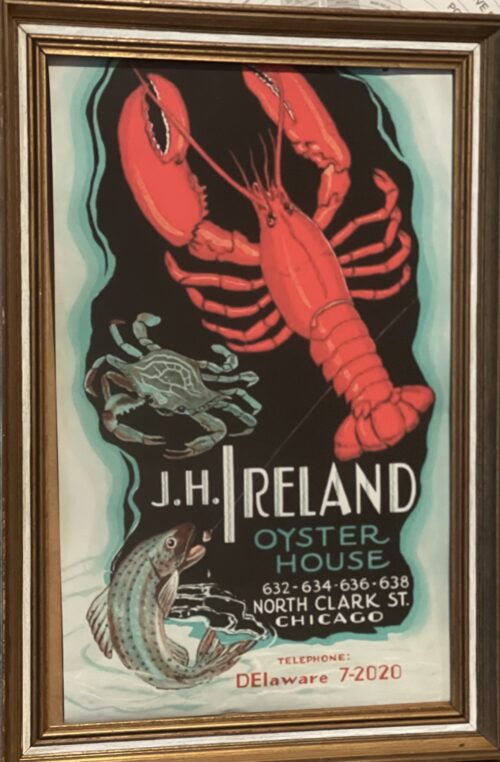
 72cm x 46cm The original J. H. Ireland Grill Room opened in Chicago in 1906, and was one of the windy city's best loved restaurants. Proprietor Jim Ireland expanded the property over two decades, adding a Lobster Grotto, a Marine Room and a banqueting hall modeled after the saloon of a passenger ship. The infamous gangster John Dillinger often dined at J. H. Ireland - he liked the frog legs - and famed attorney Clarence Darrow ate a victory dinner at the restaurant at the end of the famous Leopold and Loeb murder trial. This 1940s menu cover by folk artist Charles Jerred, in wonderfully vibrant shades of green and red, showcases what was one of Chicago's best loved restaurants and is a Love Menu Art best seller.
72cm x 46cm The original J. H. Ireland Grill Room opened in Chicago in 1906, and was one of the windy city's best loved restaurants. Proprietor Jim Ireland expanded the property over two decades, adding a Lobster Grotto, a Marine Room and a banqueting hall modeled after the saloon of a passenger ship. The infamous gangster John Dillinger often dined at J. H. Ireland - he liked the frog legs - and famed attorney Clarence Darrow ate a victory dinner at the restaurant at the end of the famous Leopold and Loeb murder trial. This 1940s menu cover by folk artist Charles Jerred, in wonderfully vibrant shades of green and red, showcases what was one of Chicago's best loved restaurants and is a Love Menu Art best seller. -

 65cm x 45cm Nun's Island Distillery was an Irish whiskey distillery which operated in Galway, Ireland, from at least 1815, and possibly as early as the late 1700s, until circa 1908. At its peak, in the late 1800s, output at the distillery reached 400,000 gallons per annum, and with a workforce of over 100, the distillery was one of the largest local employers. Owned by the Persse family from the 1840s onwards, the distillery produced single pot still whiskey known as Persse's Galway Whiskey. The whiskey was sold locally in Connacht, where for much of the 1800s, Nun's Island was the only licensed distillery.However, it was also exported, and is said to have been a sold to the British House of Commons, a fact proudly noted on their labels. Production at the distillery ceased circa 1908, with the remaining stocks wound down off over several few years. A bottle of Persse's whiskey was placed for auction in 2002 with a reserve price of £100,000 - however, it failed to sell. The bottle later sold for £3,300 in 2014.
65cm x 45cm Nun's Island Distillery was an Irish whiskey distillery which operated in Galway, Ireland, from at least 1815, and possibly as early as the late 1700s, until circa 1908. At its peak, in the late 1800s, output at the distillery reached 400,000 gallons per annum, and with a workforce of over 100, the distillery was one of the largest local employers. Owned by the Persse family from the 1840s onwards, the distillery produced single pot still whiskey known as Persse's Galway Whiskey. The whiskey was sold locally in Connacht, where for much of the 1800s, Nun's Island was the only licensed distillery.However, it was also exported, and is said to have been a sold to the British House of Commons, a fact proudly noted on their labels. Production at the distillery ceased circa 1908, with the remaining stocks wound down off over several few years. A bottle of Persse's whiskey was placed for auction in 2002 with a reserve price of £100,000 - however, it failed to sell. The bottle later sold for £3,300 in 2014.History
The early history of the distillery is somewhat difficult to piece together.It is known that a distillery on Nun's Island was being operated on by a John Joyce in the late 1700s.This distillery, which was subsequently taken over by Patrick Joyce, is thought to have ceased operations in 1807. A Patrick Joyce is recorded as running a small distillery on Nun's Island again in 1823. Therefore, it is possible that the closure was temporary. By 1828, output at the distillery had increased to 130,000 proof gallons per annum. There are claims that the distillery ceased operations again in the late 1830s.However, a newspaper advertisement from 1841 reports that a distillery "lately occupied and worked" by Messrs. James and Patrick Joyce was to be sold on 4 February 1841. The advertisement noted that the distillery was held under a 300-year lease, which had commenced in August 1815.This tallies with Alfred Barnard's 1887 report that Joyce's owned the distillery from 1815 to 1840. In about 1840 or 1841, the distillery was purchased by the Persses, a local family who ran several other distilleries in the area.There is some conflicting information with regard to the precise and nature of the sale date. Barnard reported that the distillery was sold by the Encumbered Claims Courts in 1840.However, a newspaper article from the era reports that the distillery was to be sold by private contract in February 1841. As Barnard mentions that the Persses enlarged the original operation, the confusion may be due to piecemeal purchases of different sections of the site, or delays in finalising the sale as the distillery had been repeatedly advertised for sale beginning in at least early 1840. Initially the Persses converted the distillery to a woollen mill, which was known for producing excellent friezes. However, when their lease on the nearby Newcastle Distillery expired in 1846, they moved their distilling operations at the Nun's Island complex, and re-established the site as a distillery. In 1886, the distillery was visited by British historian Alfred Barnard, as recounted in his seminal publication "The Whiskey Distilleries of the United Kingdom". Barnard noted that at the time of his visit Nun's Island was the sole distillery operating in Connacht, and had an output of about 400,000 gallons per annum. In addition to offices, workshops, stables, and storehouses, the distillery buildings included two lofty Maltings and Corn stores built of stone, five storeys of which were devoted to the storing of corn, and two to malting purposes; an elegant brew house equal to any in Ireland; a back house containing thirteen washbacks, each with a capacity of about 18,000 gallons; a still house containing a 16,000 gallon wash still, a 10,000 gallon spirit still, and a 6,000 gallon low-wines still; a spirit store occupied by a 12,000 gallon vat; and five warehouses, holding a total of about 5,000 casks at the time. Like many other Irish distilleries, Nun's Island encountered financial difficulties during the early part of the 20th Century, is thought to have closed shortly before World War I. Since closing, some of the distillery complex has been demolished. However, several of the main distillery buildings, notably the large riverside warehouse, are still extant. -
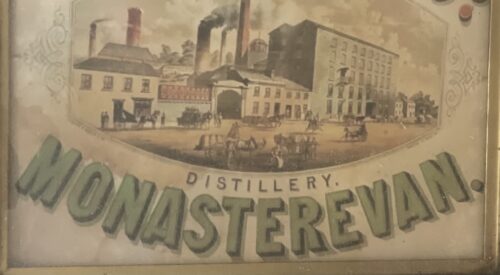
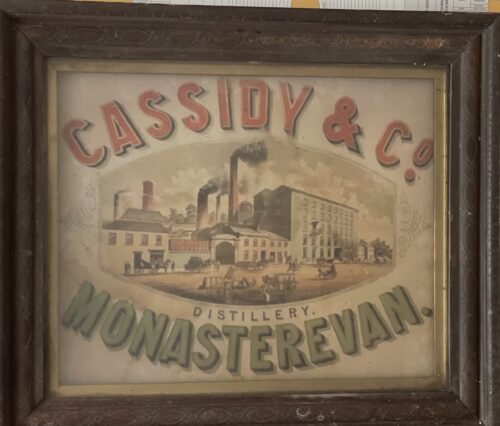 67cm x 56cm
67cm x 56cmIn 1784 Monasterevin Distillery was opened by Mr. John Cassidy. A hundred years later, in 1884 the distillery was making 250,000 gallons of whiskey a year. It was said that the "Cassidy whiskey was the best whiskey in the country".
Some of the whiskey was exported to London. It was transported to Dublin on canal boats and then shipped to England from Dublin Port. A brewery for making beer was later opened in 1860. Cassidy's Distillery and Brewery closed in 1934.
The Cassidy Family lived in Monasterevin House. They were friendly with Gerard Manley Hopkins, the famous poet. He stayed with them when he visited Monasterevin.
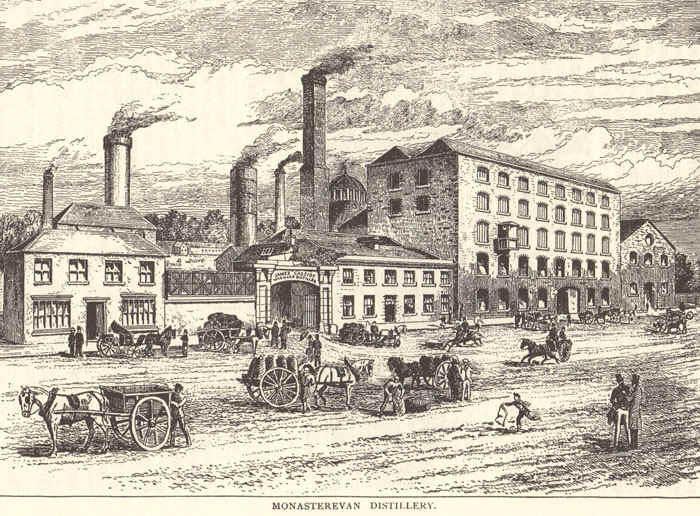
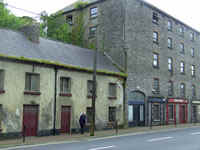
-
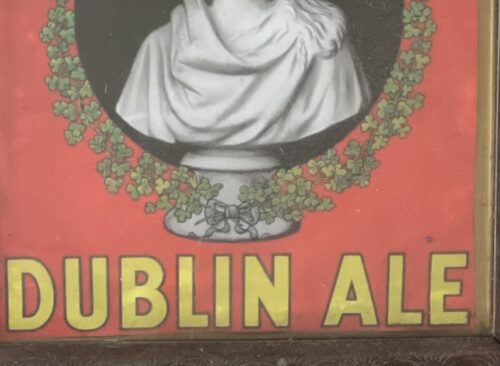
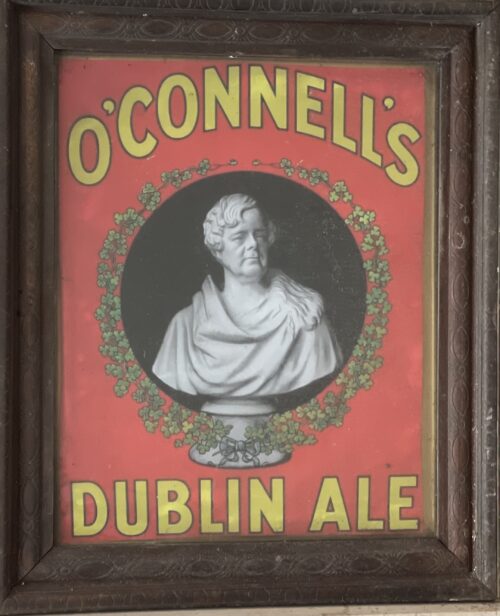 67cm x 56cm
67cm x 56cmDaniel O’Connnell Jr. had famously acquired the Phoenix Brewery in James’s street in 1831, which produced O’Connell’s Ale. It should be noted that O’Connell and the Guinness family were at times political rivals, something best captured by the 1841 ‘Repeal Election’, where O’Connell had stood against and defeated Arthur Guinness Jr. This period would see a sizeable boycott of Guinness, dubbed “Protestant Porter” by sections of the populace, though this was against the wishes of O’Connell himself.
John D’Arcy continued to brew O’Connell Ale after the family had ceased their role in brewing, and in time production moved to the Anchor Brewery in Usher Street. Watkins eventually took up the brewing of O’Connell Ale, and this advertisement was placed by them in the pages of leading newspapers in the 1930s.
While Arthur had failed to defeat O’Connell at the Ballot Box, I always wonder what O’Connell would think of the Guinness Empire today every time I see a Diaego truck pass his statue.

